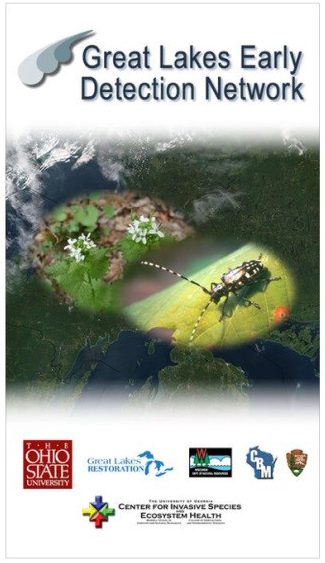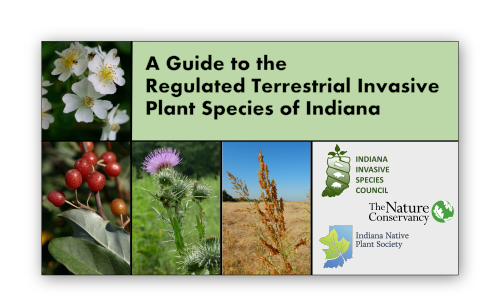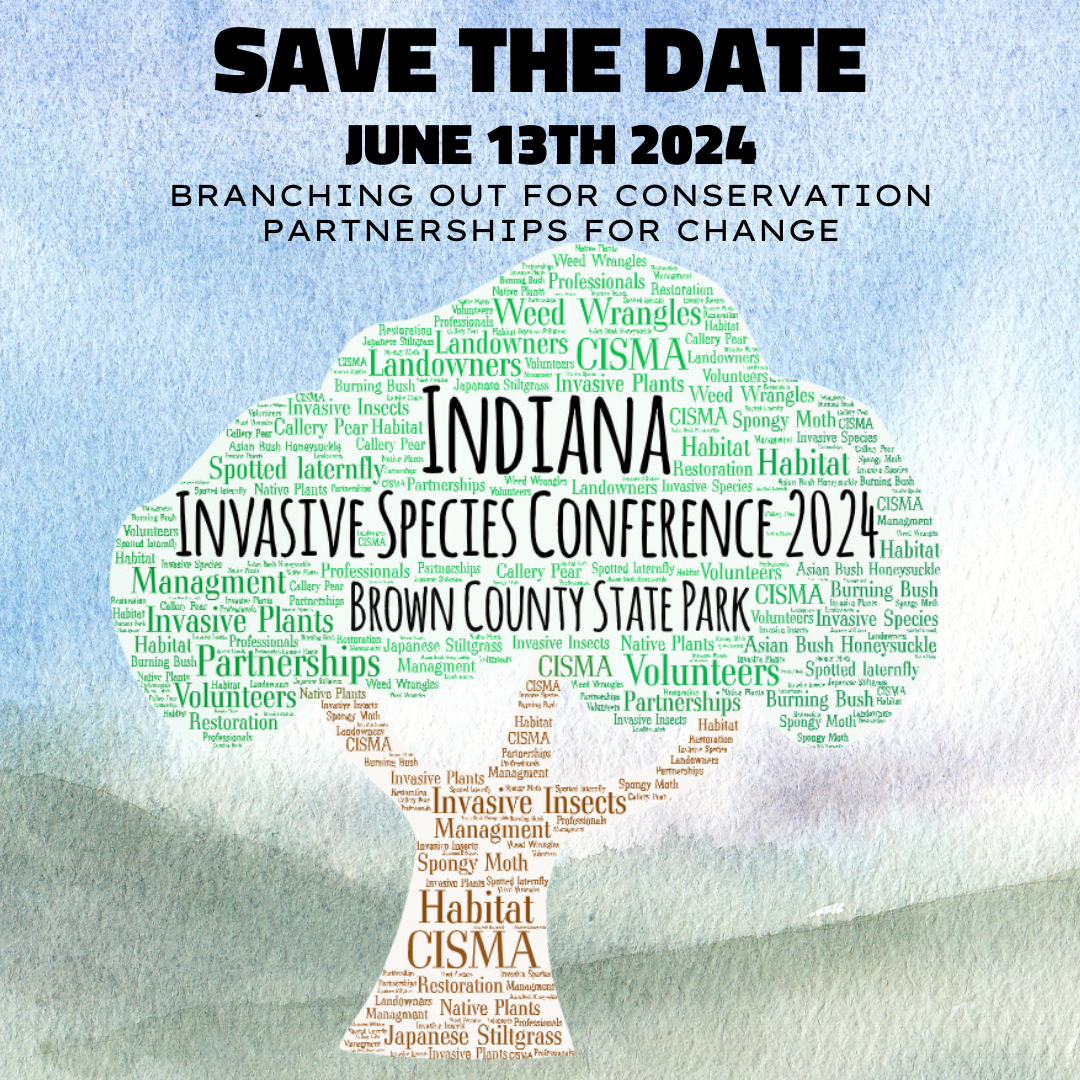Exotic invasive species are non-native plants, animals or microbes that spread aggressively, replacing native organisms and posing serious threats to human health and well-being, the environment, or our economy.
Mission
The Indiana Invasive Species Council (IISC) was established by the state legislature to enhance the ability of government agencies to detect, prevent, monitor, and manage new and long established invasions, as well as increase public awareness about invasive species.
IISC Council Members
(as of 17-May-2022)
Megan Abraham
- Representing Department of Natural Resources Division of Entomology and Plant Pathology.
- Appointed By:
- Statutory appointment
Phyllis Boyd
- Director, Indianapolis Parks & Recreation, representing land trusts, conservation and/or parks and recreation organizations.
- Appointed By:
- Governor
Eric Fischer
- Representing Indiana Department of Natural Resources’ Division of Fish and Wildlife.
- Appointed By:
- Statutory appointment
Rick Haggard
- Indiana Nursery and Landscape Association, representing the nursery industry.
- Appointed By:
- Governor
Matthew Kraushar
- Representing Indiana Department of Transportation.
- Appointed By:
- Statutory appointment
Heather Reynolds
- Professor of Biology at Indiana University, representing research.
- Appointed By:
- Governor
Kate Sanders
- Representing the Indiana Department of Agriculture.
- Appointed By:
- Statutory appointment
Joe Schmees
- IN Freshwater Strategy Manager
- The Nature Conservancy
- Representing land trusts, conservation, and/or parks & recreation
Michael Warner
- Certified Forester at ArborTerra, representing the forest industry.
- Appointed By:
- Governor
Kelli Werling
- Representing the State Board of Animal Health.
- Appointed By:
- Statutory appointment
Alicia Kelley
- IN CAPS State Survey Coordinator
- representing the Dean, College of Agriculture, Purdue University
Report It!
Report invasive plants, animals, or microbes to:
Report IN is a fast and easy way for you to report invasive species in Indiana. There are two ways to report – by computer and by smartphone. All reports will go to the appropriate organization for verification. To report by computer, go to www.EDDMapS.org/indiana and create a profile, then click Report Sightings and fill out the form.
| To report by smartphone, download the Great Lakes Early Detection Network (GLEDN) app by CLICKING HERE. This app is created and maintained by EDDMapS.org and the same EDDMapS profile can be used for both computer and smartphone reports. |
 |
| How to ReportIN on the Website | |
| How to ReportIN on your smartphone |
|
|
Forest Pest Outreach and Survey Project Emerald Ash Borer (EAB) Powerpoint Asian Longhorned Beetle (ALB) Powerpoint Thousand Canker Disease of Black Walnut (TCD) Powerpoint Hemlock Wooley Adelgid (HWA) Powerpoint |
Other ways to report:
- Invasive aquatic species
- Plant pests or pathogens: E-mail the Indiana DNR Division of Entomology and Plant Pathology
- Invasive plants: Contact the Purdue Plant and Pest Diagnostic Lab, Purdue University at 765-494-7071 or send an email
- For any type of suspected invasive species: call the Indiana DNR Invasive Species Hotline toll-free at: 1-866 NO EXOTIC (1-866-663-9684)
Events
Events, meetings, and minutes
Indiana Invasive Species Council
IISC Quarterly Meeting - Wednesday, February 14, 2024
10:30 AM Eastern
1202 E 38th Street, Discovery Hall, Suite 100
Indianapolis, IN 46205
Find on Google Maps
This public meeting will also be held virtually on the Zoom meeting platform.
Join the Meeting
Past Meeting Minutes
| Date | File Type | Status | Download |
|---|---|---|---|
| November 8, 2023 | Official | Download | |
| August 16, 2023 | Official | Download | |
| May 17, 2023 | Official | Download | |
| Feb 15, 2023 | Official | Download | |
| Nov 2, 2022 | Official | Download | |
| May 18, 2022 | Official | Download | |
| Feb 16, 2022 | Official | Download | |
| Nov 9, 2021 | Official | Download | |
| Aug 10, 2021 | Official | Download | |
| May 18, 2021 | Official | Download | |
| Feb 16, 2021 | Official | Download | |
| Nov 10, 2020 | Official | Download | |
| July 21, 2020 | Official | Download | |
| May 19, 2020 | Official | Download | |
| Feb 18, 2020 | Official | Download | |
| Dec 17, 2019 | Official | Download | |
| Jul 23, 2019 | Official | Download | |
| May 21, 2019 | Official | Download | |
| Feb 28, 2019 | Official | Download | |
| Nov 28, 2018 | Official | Download | |
| Jul 25, 2018 | Official | Download | |
| May 9, 2018 | Official | Download | |
| Jul 25, 2017 | Official | Download | |
| May 5, 2017 | Official | Download | |
| Feb 1, 2017 | Official | Download | |
| Nov 10, 2016 | Official | Download | |
| Sep 14, 2015 | Official | Download | |
| Mar 6, 2015 | Official | Download | |
| Sep 23, 2014 | Official | Download | |
| Jun 5, 2014 | Official | Download | |
| Feb 14, 2014 | Official | Download | |
| Oct 11, 2013 | Official | Download | |
| May 22, 2013 | Official | Download | |
| Sep 26, 2012 | Official | Download | |
| Apr 25, 2012 | Official | Download | |
| Apr 5, 2011 | Official | Download | |
| Mar 4, 2010 | Official | Download |

Invasive Plant Advisory Committee
The Invasive Plant Advisory Committee (IPAC) was created in August 2010 to work on
invasive plant projects that support the mission of the IISC.
If you have questions or comments about IPAC or invasive terrestrial plants please contact, Dawn Slack at dawn@sicim.info
Invasive Plant Management Cost Hoosiers over $5 million in 2012
A recent survey conducted by the Invasive Plant Advisory Committee found that land owners and managers in Indiana spent $5.85 million in 2012 to manage invasive plants on their land.
Alternative Plant Choices
Callery Pear Nursery trade letter
Callery Pear Survivor Tree letter

Download PDF (8.2MB):
Management Resources
Cooperative Invasive Species Management Areas (CISMAs) and Cooperative Weed Management Areas (CWMAs)
CISMAs / CWMAs are local organizations that bring together landowners and land managers, local, state and federal agencies, tribes, individuals and various interested groups to coordinate action and share expertise and resources to manage invasive species in a defined area. This collaborative effort at the local level enables CISMAs to pool resources and knowledge to address mutual invasive species issues.
CISMAs and CWMAs:
- Operate within a defined geographic area, distinguished by a common geography, invasive species problem, community, climate, political boundary, or land use;
- Involve a broad cross-section of landowners and natural resource managers within its defined boundaries;
- Are governed by a Steering Committee;
- Make a long-term commitment to cooperation, usually through a formal agreement among partners;
- Have a comprehensive plan that addresses the management or prevention of invasive species within its boundaries; and
- Facilitate cooperation and coordination across jurisdictional boundaries.
CISMAs and CWMAs bring together local citizens, landowners, non-profit organizations, industry, and city, county, state, tribal, and federal representatives to work towards a common goal—effective control of invasive species.
| Counties Covered | CISMA Name | Point of Contact | Website | |
| Lake, LaPorte, Porter | Indiana Coastal Cooperative Weed Management Area (ICCWMA) | Susan Mihalo | smihalo@TNC.ORG | Visit Site |
| LaGrange, Stueben | Lakes County Cluster Cooperative Weed Management Area (LCC) | Beth Williams and Nate Simons | bw_consulting@frontier.com, stuartbheron1@hotmail.com | Visit Site |
| Brown | Brown County Native Woodlands Project (BCNWP) | Dan Shaver | dshaver@TNC.ORG | Visit Site |
| Monroe | Monroe County Identify and Reduce Invasive Species (MC-IRIS) | Ellen Jaquart | mciris2010@gmail.com | Visit Site |
| Owen | Owen County CISMA - Sweet Owen Woodland Network (SOWN) | Andrea Oeding | andrea-oeding@iaswcd.org | N/A |
| Knox | Knox County Cooperative Weed Management Area | Will Drews | willem.drews@in.nacdnet.net | Visit Site |
| Dubois | Invasive Species Awareness Coalition of Dubois County (ISAC) | Ron Ratham | ronr@purdue.edu | Visit Site |
| Lawrence | Lawrence County CWMA - Keep Invasives in Check (KIC) | Cheryl Coon | ccoon@fs.fed.us | Visit Site |
| Jackson | Jackson County Cooperative Invasive Species Management Area | Terri Ault | Terry.Ault@in.nacdnet.net | N/A |
| SICIM covers 35 counties in the southern part of the state | Southern Indiana Cooperative Invasives Management (SICIM) | Will Drews | willem.drews@in.nacdnet.net | Visit Site |
Invasive Plant Removal Contractors
Download this PDF file for a list of invasive plant removal contractors in Indiana.
Tools to Manually Remove Invasive Shrubs
Download this PDF file for a detailed summary of tools available to pull Asian bush honeysuckle or other invasive shrubs from the ground.
For more information on invasive plants in Indiana

